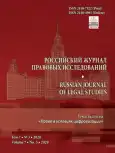Хищение как причинение ущерба и как противоправное изъятие: доктринальные и правоприменительные проблемы
- Авторы: Хилюта В.В.1
-
Учреждения:
- УО «Гродненский государственный университет им. Янки Купалы»
- Выпуск: Том 7, № 3 (2020)
- Страницы: 72-82
- Раздел: Уголовно-правовые науки
- URL: https://journals.rcsi.science/2410-7522/article/view/46051
- DOI: https://doi.org/10.17816/RJLS46051
- ID: 46051
Цитировать
Аннотация
В настоящее время наблюдается переформатирование уголовно-правовых институтов и основных концепций. В работе уделяется существенное внимание объективным признакам хищения и способу деятельности — изъятию чужого имущества. Критически воспринята существующая правоприменительная практика и действующие рекомендации Пленума Верховного Суда Российской Федерации по квалификации хищений. Предметом статьи являются положения общей теории уголовного права о квалификации хищений. Цель исследования — обоснование необходимости корреляции объективных признаков хищения применительно к расширению границ предмета хищения и способа деятельности. При проведении исследования использовались традиционные методы социально-правового и формально-догматического анализа: документальный, сравнительно-правовой, аналитический, системный, логический. По результатам исследования предложено внести коррективы в понимание объективной стороны хищения и расширить границы способа действия. Изъятие чужого имущества не может характеризовать механизм совершения хищений и полностью отражать всевозможные аспекты квалификации. Перспектива отождествления хищения с извлечением (получением) имущественной выгоды таит в себе опасность стирания границ между хищением и иными экономическими преступлениями. Автором предложены модели развития уголовного законодательства в области установления уголовной ответственности за преступления против собственности (имущественные преступления). В контексте тенденции видоизменения предмета хищения, его цели и способа деятельности предлагается выделить новую группу преступлений (преступления против оборота объектов гражданских прав), которые бы охватывали противоправные деяния против имущественных и обязательственных отношений. Дальнейшая научная проработка требует детального размежевания хищений (как посягательств на телесные блага), преступлений против оборота гражданских прав (как посягательств на нетелесные блага) и преступлений в сфере экономической деятельности (как посягательств на порядок совершения операций в экономике), обобщения их характерных признаков и конструирования новых составов преступлений в имущественной сфере.
Полный текст
Открыть статью на сайте журналаОб авторах
Вадим Владимирович Хилюта
УО «Гродненский государственный университет им. Янки Купалы»
Автор, ответственный за переписку.
Email: tajna@tut.by
кандидат юридических наук, доцент, доцент кафедры уголовного права, уголовного процесса и криминалистики
Белоруссия, г. ГродноСписок литературы
- Бойцов А.И. Преступления против собственности. СПб.: Юридический центр Пресс, 2002. 775 с.
- Лопашенко Н.А. Посягательства на собственность. М.: Норма: ИНФРА-М., 2012. 528 с.
- Хилюта В.В. Преступления против оборота объектов гражданских прав. М.: Юрлитинформ, 2017. 352 с.
- Хилюта В.В. Кража и присвоение найденного имущества. М.: Юрлитинформ, 2018. 224 с.
- Гаухман Л.Д., Максимов С.В. Ответственность за преступления против собственности. М.: Юринфор. 1997. 320 с.
- Безверхов А.Г. Имущественные преступления. Самара: Изд-во «Самарский университет», 2002. 359 с.
- Адоевская О.А. Ответственность за кражу по современному праву России. М.: Юрлитинформ, 2012. 208 с.
- Уланова Ю.Ю. Общие признаки хищения в составе кражи. М.: Юрлитинформ, 2013. 304 с.
- Шульга А.В. Хищения в условиях развития современных информационных технологий и рынка инновационных товаров. М.: Юрлитинформ, 2016. 272 с.
Дополнительные файлы







